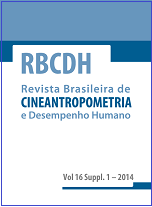Efetividade de uma intervenção de base escolar sobre o tempo de tela em estudantes do ensino médio
DOI:
https://doi.org/10.1590/1980-0037.2014v16s1p25Resumo
Embora os efeitos sejam pequenos, algumas intervenções para a redução do comportamento sedentário em jovens têm sido bem sucedidas. O objetivo do estudo foi verificar a efetividade de uma intervenção de base escolar para promoção da atividade física e hábitos alimentares saudáveis sobre indicadores de tempo de tela em escolares. Trata-se de um estudo de intervenção randomizado e controlado com estudantes (15 a 24 anos) do ensino médio do período noturno de escolas públicas de duas capitais brasileiras: Florianópolis e Recife. A coleta de dados foi realizada no início (março) e ao final (dezembro) do ano letivo de 2006, mediante aplicação de um questionário. Os estudantes que relataram despender duas ou mais horas por dia assistindo televisão ou jogando videogame/usando o computador em dias de semana ou em dias do fim de semana foram considerados expostos ao tempo de tela. Estas análises foram conduzidas mediante utilização de regressão logística. Dos 2.155 escolares incluídos na linha de base, 989 foram avaliados no período pós-intervenção. Observou-se que o grupo intervenção reduziu significativamente a exposição ao tempo de videogame / computador nos dias de fim de semana quando comparado ao grupo controle (29,8% vs 35,6%, respectivamente; p=0,004). Após ajustamento para potenciais fatores de confusão, verificou-se que a intervenção não teve efeito significativo na redução da exposição ao tempo de tela nos escolares investigados. O modelo de intervenção adotado no projeto Saúde na Boa não foi efetivo em reduzir o tempo de tela de estudantes do ensino médio.
Downloads
Publicado
Edição
Seção
Licença

Direitos Autorais para artigos publicados nesta revista são do autor, com direitos de primeira publicação para a revista. Em virtude da aparecerem nesta revista de acesso público, os artigos são de uso gratuito, com atribuições próprias, em aplicações educacionais e não-comerciais, desde que seja dada a atribuição. Esta obra foi licenciada com uma Licença Creative Commons Atribuição 4.0 Internacional - CC BY


